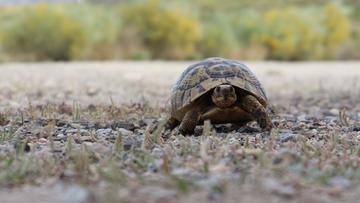New research has revealed that the most endangered turtle and crocodile species are those that are most unique. Their loss could have widespread impacts on the ecosystems they live in, since they carry out critical processes important for many other species.

A spur-thighed tortoise
Image: Marcos Altuve
Turtles and crocodiles are two of the world's most endangered animal groups, with approximately half of species globally threatened (International Union for Conservation of Nature, IUCN). Greater understanding on which species are most threatened and why is urgently needed to inform conservation efforts to save them.
In a new study led by researchers at the Department of Biology, an international team examined the greatest risks to wild populations of turtles and crocodiles worldwide. The results show that the most endangered turtles and crocodile species are those that have evolved unique life strategies. These species typically carry out highly specific roles within their ecosystems that are unlikely to be taken up by other species if they disappeared.
The researchers used models to simulate extinctions as a result of human-led threats, assessing the impacts that would be seen for species with different life strategies. A life strategy is how an organism divides its resources and energy between its own survival, reproduction, and growth. Professor Rob Salguero-Gómez, senior author of this research, commented:
A key finding is that the threats do not affect all species equally; they tend to impact particular life history strategies. For example, unsustainable consumption of turtles and crocodiles mainly affects the longest-lived species with the largest clutch sizes, such as sea turtles.
According to the researchers, the fact that tortoises, turtles, and crocodiles with unique life histories are more vulnerable to vanishing is highly concerning, since many of these perform important functions in ecosystems. For instance, some are effective seed dispersers, some create habitats for other species by making burrows, and others are predators that help maintain balance in the ecosystem. Having had these functions for millions of years, they are inextricably tied to the unique and diverse life strategies that species have evolved. Many of these species are also highly charismatic, such as the ‘spur-thighed tortoise’, native to the Mediterranean basin in the north of Africa and the East of Europe. Dr Roberto Rodriguez, lead author of the study, said:
The main threat to the viability of these groups of reptiles is habitat loss and fragmentation, which is especially common in species inhabiting the Northern hemisphere. The disappearance of wetlands, increasing urbanisation, and the development of intensive agriculture, which already have tangible effects, will likely continue to negatively affect these species and their ability to persist in the mid- to long-term.
Other threats, however, had a more global and untargeted effect. Dr Molly Grace, co-author of the study, added: “While sustainable use and trade of wildlife can sometimes benefit species conservation, unsustainable trade of live animals or their parts threaten these reptiles throughout the world, regardless of their life history strategies.” The capture and trafficking of turtles is common for keeping them in captivity, and crocodile skin is of great commercial interest; for example, although there are some controls on trade, Mugger crocodile (Crocodylus palustris) in Pakistan is still illegally hunted for its skin.
The results highlight the urgent need for effective conservation management plans that protect species overall, but also unique life history strategies and functional diversity. Incorporating functional diversity into conservation policies for these highly endangered groups may be a promising approach to help prioritise conservation efforts in the face of current and future threats. “IUCN red list species could incorporate information regarding the functional uniqueness to help managers make local decisions that would impact global conservation most efficiently,” added Dr Rob Salguero-Gómez.
The researchers add that people can support organisations that develop conservation projects to protect their habitats and wild populations. Responsible ecotourism or citizen science activities, such as volunteering programmes or crowdsourced data collection, can also offer opportunities to positively contribute towards turtle and crocodile conservation.
To read more about this research, published in Nature Communications, visit: https://www.nature.com/articles/s41467-023-37089-5.